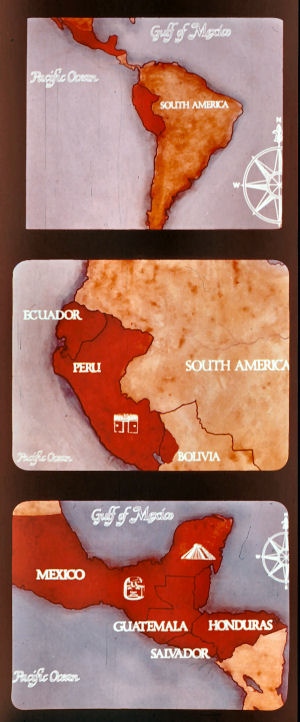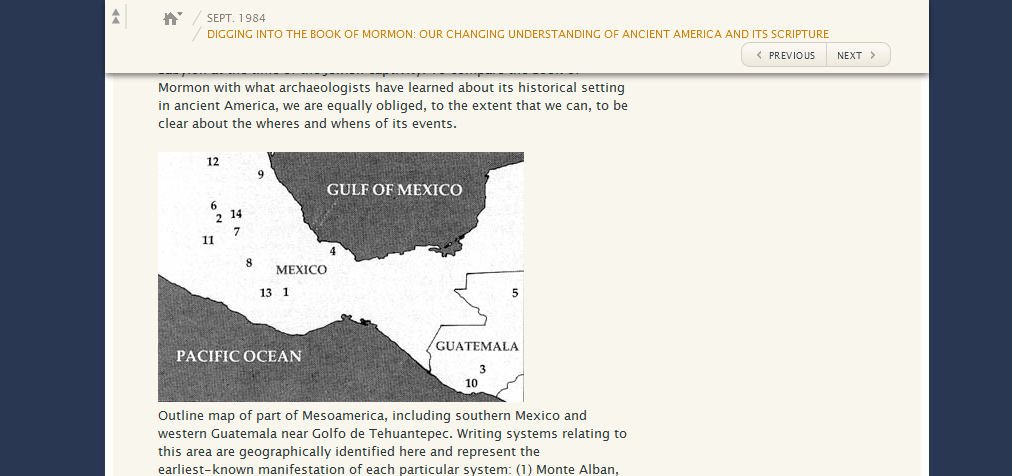
FAIR is a non-profit organization dedicated to providing well-documented answers to criticisms of the doctrine, practice, and history of The Church of Jesus Christ of Latter-day Saints.
DavidSmith (talk | contribs) m (DavidSmith moved page Question: If the gold plates were originally in Mesoamerica, how did they get to New York? to Mesoamerican Model of Book of Mormon geography: part of content consolidation and simplification project) |
DavidSmith (talk | contribs) (part of content conslidation and simplification project) |
||
| Line 1: | Line 1: | ||
{{ | {{Main Page}} | ||
{{Navigation Book of Mormon}} | |||
{{Header}} | |||
==Question: If the gold plates were originally in Mesoamerica, how did they get to New York?== | ==Question: If the gold plates were originally in Mesoamerica, how did they get to New York?== | ||
===The answer to this question is not known, but informed speculation demonstrates that this poses no difficulty=== | ===The answer to this question is not known, but informed speculation demonstrates that this poses no difficulty=== | ||
| Line 19: | Line 23: | ||
[[File:Screenshot_4.png]] | [[File:Screenshot_4.png]] | ||
{{:Question: What is the Limited Geography Theory and model?}} | |||
{{:Question: Has the Church ever promoted a Limited Geography model for the Book of Mormon?}} | |||
{{:Source:Roper:FR 16:2:Critics of the Book of Mormon have claimed that the limited geography is only a late, desperate attempt}} | |||
{{:Question: Was the Limited Geography model created in response to DNA claims?}} | |||
{{endnotes sources}} | {{endnotes sources}} | ||
At the end of his record Moroni tells us that "more than four hundred and twenty years have passed away since the sign was given of the coming of Christ" (Moroni 10꞉1). This means that Moroni wandered for 36 years after the destruction of his people (421 – 385 = 36). This was more than enough time for him to travel a wandering course by foot from Mesoamerica to New England. And it makes sense that he would travel far, as he wanted to get as far as possible from the Lamanites.
Years ago, John Sorenson noted that such distances pose no difficulty whatever:
Would Moroni have been able to survive a trip of several thousand miles through strange peoples and lands, if he did transport the record? Such a journey would be no more surprising than the trip by Lehi's party over land and by sea halfway around the globe. As a matter of fact, we do have a striking case of a trip much like the one Moroni may have made. In the mid-sixteenth century, David Ingram, a shipwrecked English sailor, walked in 11 months through completely strange Indian territory from Tampico, Mexico, to the St. John River, at the present border between Maine and Canada. His remarkable journey would have been about the same distance as Moroni's and over essentially the same route. So Moroni's getting the plates to New York even under his own power [in 36 years] seems feasible.[1]
Google Maps has the journey from the Tuxtla Mountain Range in south Veracruz Mexico to Manchester, NY taking 850 hours which is equivalent to about 35 days of non-stop walking.
The Limited Geography Theory (or LGT) is a non-traditional interpretation of the text, but one that has gained wide acceptance among the Book of Mormon scholars and readers over the last 60 years.[2] It is based on a close reading of the text, which indicates that the lands inhabited by the Lehites could be traversed on foot in only a few weeks, making the area no larger than present-day California.
Advantages of this model:
Disadvantages include:

Has the Church ever promoted a Limited Geography model for the Book of Mormon? The answer to that question is yes. The Church filmstrip "Ancient America Speaks" was heavily used by missionaries in the 1970s. It included a map which indicated that Nephite and Lamanite lands were distinct and separated by the Isthmus of Panama.
In September and October of 1984, the official Church magazine the Ensign printed a two-part series which outlined the limited geography model for the Book of Mormon. The articles were called "Digging into the Book of Mormon: Our Changing Understanding of Ancient America and Its Scripture" and were written by Latter-day Saint anthropologist John L. Sorenson. Sorenson notes:
Many Latter-day Saints have not had access to sources which communicate how recent research has changed our understanding of the Book of Mormon as an ancient document. Many also are unaware of some rather surprising new discoveries supporting the Book of Mormon which have been brought about by the advanced methods of science. The purpose of this article and the one to follow is to sketch a few vivid examples of changes in how some Latter-day Saint scholars view the Book of Mormon in the light of new theories and discoveries about the past. These articles are not intended to be an expression of official Church teachings, but on the basis of my own research and study, I have thought this new information to be worth consideration. [3]
Matthew Roper:
Recently, some critics of the Book of Mormon have claimed that the limited geography is only a late, desperate attempt to defend the Book of Mormon. It is, they assert, contrary "to the Book of Mormon text, early Mormon history, [and] Joseph Smith's divine edicts."2 In order to place the assertions of these critics in perspective, it is necessary to address several questions: What was the hemispheric geography based on? Granted that this early view was popular, was it based on revelation? Is there any authoritative interpretation of Book of Mormon geography? Is the localized geography some kind of debater's ploy or are there substantial reasons for this view? [4] —(Click here to continue)
Was the Limited Geography model created in respond to DNA claims? The answer is no. The idea that Lehi's party entered a larger, pre-existing New World population was introduced as early as 1927, well before the Book of Mormon was being challenged on issues related to DNA. [5] Limited Geography Models in General have been present since at least 10 years before that.
An examination of both Part 1 and Part 2 of John Sorenson's 1984 Ensign articles quickly shows that they do not even contain the term "DNA". The articles focus on anthropological and geographical topics which support the Limited Geography model.
I have said repeatedly that the correspondences in geography, history, and cultural patterns—large scale or micro-scale—between Mesoamerican cultures and the Book of Mormon peoples do not “prove” anything conclusively. Still, the fact that large numbers of such correspondences exist ought to register in the minds of truth-loving people. With this in mind, it is clearly misleading for a scholar—one of our own—to imply that there is no “important archaeological evidence” to support the Book of Mormon story “of Indian origins,” or for another to find it amusing to think that anyone would seriously try to compare the Book of Mormon with objective facts of historical importance. [6]


FAIR is a non-profit organization dedicated to providing well-documented answers to criticisms of the doctrine, practice, and history of The Church of Jesus Christ of Latter-day Saints.
We are a volunteer organization. We invite you to give back.
Donate Now